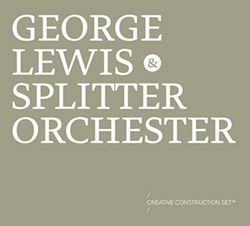
I had the good fortune to see the Splitter Orchester twice in recent years, once in Paris and once in Huddersfield, the latter event occurring three or so weeks after the recording in question. In Paris, they ably skirted what is treacherous ground for any large, improvising ensemble by creating an air-filled, unencumbered sonic space, very clearly limned with delicate tracings of sound, anchored by the placement of percussionists Burkhard Beins and Morten J. Olsen on opposite corners (playing horizontally-oriented bass drums) of a kind of square set up, their diagonal "conversation" serving as a scaffolding of sorts upon which the other instrumentalist strung their lines. In Huddersfield, arrayed over a large interior space that allowed the listener to move freely about, the result was less successful; one had the impression that they're best served when there's some overarching compositional aspect in effect though that clearly may have been an isolated instance.
For this meeting, George Lewis concocted a set of strategies loosely based on memories of The Creative Construction Company, an early 70s ensemble made up of various AACM-affiliated musicians (and which released two very fine albums on Muse). The piece involves text instructions/prompts written on cards distributed to twenty-four Splitter members (Including, among others, Werner Dafeldecker, Kai Fagaschinski, Axel Dörner, Magda Mayas, Andrea Neumann and Clayton Thomas, plus Lewis himself) which not only seek to evoke musical responses but, perhaps more importantly, social ones with regard to cooperation, group formation, individuality within a group experience, etc. It's the sort of experience that necessarily loses something when heard via recording — a well-made video document would go further in fulfilling that ideal — but with a bit of imagination, the listener can at least begin to get a grasp on what had occurred. Three selections, probably culled from a wider set, are offered here.
The first (#3) immediately enters dense, resonant territory but remains clear, the heavy percussion, splattered brass and siren sounds from somewhere slicing through the thick atmosphere. The track proceeds to dissipate and sharply recollect in an appropriately unpredictable manner, the musicians presumably forming alliances, debating tactics and perhaps choosing secession. It has an endearing stumbling, lurching quality, the mostly heavy and dark sounds banging off one another, but playfully, before ending gently with drones and plucked metal strings. #1, the second track, is a harsher affair, the sounds generally pitched higher, grainier, more splintered, incorporating tapes at the start. It's more difficult to attempt to follow any cooperative procedures, but eventually a steady, low piano figure from Mayas or Simon James Phillips emerges, serving as something of a spine, or at least tendril, off of which sprout a bewildering set of brief, curling sounds. Again, the work shifts abruptly near its conclusion, developing sets of discrete tutti flourishes connected by the thinnest of strands. The final portion, #2, is probably the most problematic, the music entering a more diffuse, disparate and superficially scattered and non-homogenous phase for its first half, though still remaining fascinating; one can only guess at the levels of cooperation (or not) that took place. Ultimately, cohesion arrives in the form of an enormous welter of percussive bangs, strangulated brass, fluttering electronics and deep, rapid arco bass and cello. Very satisfying.
A strong effort and bracing to hear what Lewis can evoke and provoke in a large grouping of very talented, improvising musicians.
Comments and Feedback:
|



